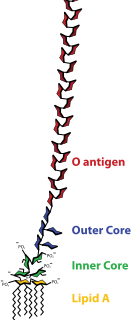
In bacteriology, gram-positive bacteria are bacteria that give a positive result in the Gram stain test, which is traditionally used to quickly classify bacteria into two broad categories according to their type of cell wall.

Gram-negative bacteria are bacteria that do not retain the crystal violet stain used in the Gram staining method of bacterial differentiation. They are characterized by their cell envelopes, which are composed of a thin peptidoglycan cell wall sandwiched between an inner cytoplasmic cell membrane and a bacterial outer membrane.

Lipopolysaccharides (LPS) are large molecules consisting of a lipid and a polysaccharide composed of O-antigen, outer core and inner core joined by a covalent bond; they are found in the outer membrane of Gram-negative bacteria. The term lipooligosaccharide ("LOS") is used to refer to a low-molecular-weight form of bacterial lipopolysaccharides.

Sphingomonas was defined in 1990 as a group of Gram-negative, rod-shaped, chemoheterotrophic, strictly aerobic bacteria. They possess ubiquinone 10 as their major respiratory quinone, contain glycosphingolipids (GSLs), specifically ceramide, instead of lipopolysaccharide (LPS) in their cell envelopes, and typically produce yellow-pigmented colonies.

Lipid A is a lipid component of an endotoxin held responsible for the toxicity of gram-negative bacteria. It is the innermost of the three regions of the lipopolysaccharide (LPS), also called endotoxin molecule, and its hydrophobic nature allows it to anchor the LPS to the outer membrane. While its toxic effects can be damaging, the sensing of lipid A by the human immune system may also be critical for the onset of immune responses to gram-negative infection, and for the subsequent successful fight against the infection.

Lipopolysaccharide binding protein (LBP) is a protein that in humans is encoded by the LBP gene.

Pasteurella multocida is a Gram-negative, nonmotile, penicillin-sensitive coccobacillus of the family Pasteurellaceae. Strains of the species are currently classified into five serogroups based on capsular composition and 16 somatic serovars (1–16). P. multocida is the cause of a range of diseases in mammals and birds, including fowl cholera in poultry, atrophic rhinitis in pigs, and bovine hemorrhagic septicemia in cattle and buffalo. It can also cause a zoonotic infection in humans, which typically is a result of bites or scratches from domestic pets. Many mammals and birds harbor it as part of their normal respiratory microbiota.
Shewanella gelidimarina is a species of bacteria, notable for being an Antarctic species with the ability to produce eicosapentaenoic acid. It grows anaerobically by dissimilatory Fe (III) reduction. Its cells are motile and rod shaped. ACAM 456 is its type strain.
Shewanella frigidimarina is a species of bacteria, notable for being an Antarctic species with the ability to produce eicosapentaenoic acid. It grows anaerobically by dissimilatory Fe (III) reduction. Its cells are motile and rod shaped. ACAM 591 is its type strain.
Psychrobacter jeotgali is a species of bacteria named after jeotgal, a traditional Korean fermented seafood, where it was first isolated. It is a Gram-negative, non-motile, non-spore-forming, and moderately halophilic coccus. The type strain is YKJ-103T.
Psychrobacter arcticus is a Gram-negative, nonmotile species of bacteria first isolated from Siberian permafrost. Its type strain is 273-4T.
Psychrobacter is a genus of Gram-negative, osmotolerant, oxidase-positive, psychrophilic or psychrotolerant, aerobic bacteria which belong to the family Moraxellaceae and the class Gammaproteobacteria. The shape is typically cocci or coccobacilli. Some of those bacteria were isolated from humans and can cause humans infections such as endocarditis and peritonitis. This genus of bacteria is able to grow at temperatures between −10 and 42 °C. Rudi Rossau found through DNA-rRNA hybridization analysis that Psychrobacter belongs to the Moraxellaceae. The first species was described by Juni and Heym. Psychrobacter occur in wide range of moist, cold saline habitats, but they also occur in warm and slightly saline habitats.
Psychrobacter adeliensis is a Gram-negative bacterium of the genus Psychrobacter which was isolated from fast ice in the middle of the Geologie Archipelago in Adelie Land in the Antarctica.
Psychrobacter glacincola is a Gram-negative, oxidase- and catalase-positive, halotolerant, nonmotile bacterium of the genus Psychrobacter, which was isolated from the anchor ice of Amery Ice Shelf in Antarctica. It is strictly oxidative and coccus-shaped; its type strain is ACAM 483T.
Psychrobacter phenylpyruvicus is a Gram-negative, catalase- and oxidase-positive, nonmotile bacterium of the genus Psychrobacter, which was isolated from human blood in Belgium. Psychrobacter phenylpyruvicus can cause humans infections such as endocarditis, peritonitis, and fungating lesion of the foot, but those infections caused by this bacterium are rare.
Psychrobacter proteolyticus is a species of bacteria first isolated from the Antarctic krill Euphausia superba. It excretes a cold-adapted metalloprotease. It is a strictly aerobic, strongly oxidase-positive, psychrotrophic, halotolerant, Gram-negative nonmotile coccobacillus; its type strain is CIP106830T (=DSM13887).
Psychrobacter pulmonis is a Gram-negative, catalase- and oxidase-positive, strictly aerobic, nonmotile bacterium of the genus Psychrobacter, which was isolated from the lungs of lambs in Zaragoza in Spain. It is coccus-shaped; the type strain is S-606T.
Psychrobacter salsus is a Gram-negative, strictly aerobic bacterium of the genus Psychrobacter, which was isolated from the fast ice in the middle of Geologie Archipelago in Adelie Land in Antarctica.
Psychrobacter sanguinis is a Gram-negative, strictly aerobic bacterium of the genus Psychrobacter, which was isolated from human blood in New York.
Methanocalculus halotolerans is a species of archaeon, the type species of its genus. It is an irregular coccoid hydrogenotrophic methanogen. Its type strain is SEBR 4845T.






